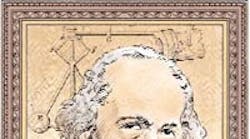James Watt, a Scottish inventor and mechanical engineer, is known for his improvements to the steam engine. At 19, he began work as a mathematical instrument maker and became fascinated with improving the steam engine, used at the time primarily for pumping water from mines. Watt determined the properties of steam, including the relation of its density to its temperature and pressure, and designed a separate condensing chamber for the steam engine that prevented large losses of steam in the cylinder and improved vacuum conditions. Other significant inventions include the rotary engine for driving various types of machines; the double-action engine, in which steam is admitted alternately into both ends of the cylinder; and the steam indicator, which records steam pressure in the engine. He invented the centrifugal or “flyball” governor in 1788 to automatically regulate engine speed, using the feedback principle of a servomechanism, linking output to input — the basic concept of automation. Watt coined the term “horsepower,” and the electrical unit — “watt” — is named in his honor.
Alessandro Volta, an Italian physicist, is renowned for his discoveries and work with electricity. In 1774 Volta became a physics professor at the Royal School in Como, and the next year developed the “electrophorus,” an instrument that produced charges of static electricity. He then delved into chemistry, studying atmospheric electricity and devising experiments such as the ignition of gases by an electric spark in a closed vessel. By 1800 Volta had developed the “voltaic pile,” a forerunner of the electric battery, which produced a steady stream of electricity. The voltaic pile involved stacking round plates of copper and zinc separated by cardboard disks that were moistened with salt solution. In honor of his work, Napoleon made him a count in 1801. The electrical unit — “volt” — is named in his honor.
Andre Marie Ampere, a French physicist and mathematician, is highly regarded as the first to establish the importance of the relationship between electricity and magnetism. Ampere argued that magnetism could be explained by electric currents in molecules; he then invented the solenoid, which behaved as a bar magnet. He also showed that parallel wires with current in the same direction attract and those with current in opposite directions repel. He termed the study of currents “electrodynamics” and developed a wave theory of heat. Ampere made contributions to chemistry as well, and produced a classification of the elements in 1816. His most important treatise on electricity and magnetism was published in 1826, and this theory became fundamental for 19th century developments in electricity and magnetism. The unit of electric current — “ampere” — is named in his honor.
